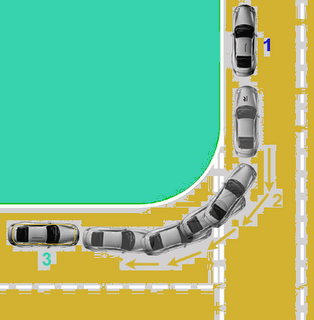The Road to Hell (Part 2)
I’ve spent the last two months preparing for my driving test. While immigrants from EU countries can simply show their current license and passport and get issued a U.K. license, the rest of us have to go through the same process as British teens.
First, there's the Provisional Driver’s License, which is similar to a driver’s permit in the U.S. To get one, I needed to show proof of identity, fill out a form and pay a £38 fee (about $68). http://www.dvla.gov.uk/drivers/applydl.htm
After getting the PDL in the mail, I contacted one of a billion driver’s training schools. John, my instructor, assessed my driving skills by having me drive around St. Andrews for a couple of hours. Then he gave me a study guide CD for the written portion of the test, which I have to pass before I’m allowed to take the practical test.
The written test has two parts: a multiple-choice theory test and a hazard perception test. The 35 theory questions are similar to what you would find on the U.S. written test. The hazard test consists of 14 video clips that simulate driving on varying types of roads at different times of day. During each clip there is a developing hazard that you are suppose to recognize. As soon as you spot it, you let the computer know by clicking your mouse. http://www.2pass.co.uk/hazardtest.htm
A few weeks later, my test day arrived. On the way to the test center, a pheasant decided to run out in front of my speeding car. As I pulled into the parking lot, I wondered if hitting deranged birds could be considered a bad omen.
The man at reception checked my PDL and instructed me to put my coat and purse in a locker. Then he handed me off to another man who led me to a small cubicle containing headphones and a computer. After taking the practice tests, I sailed through the multiple choice. The hazard perception part was going okay as well until my finger spasmed, clicking the mouse a couple of times in quick succession. The program determined I was cheating and gave me a zero for that clip, causing me to shout at the screen until I remembered where I was. Fortunately, I still received enough points to pass.
Meanwhile, I had been taking weekly driving lessons. Each hour and a half lesson costs £33, while the testing fees set me back another £70. For the practical test, I will need to correctly execute several maneuvers that are supposed to show my adeptness at driving:
- Emergency stop – A wayward pheasant might qualify, though only if I’m not endangering a driver behind me.
- Parallel parking – Even though I didn’t get much of an opportunity to do this in the U.S., it’s obviously something I need to know how to do.
- Three-point turn on a side street – I’ve done this a few times in the absence of a driveway to turn around in.
- Backing into a parking space – I’m in unfamiliar territory here, but it’s apparently safer because your visibility's greater when you’re pulling out.
 Reversing around a corner – I have no idea why anyone would ever have the need to do this. And of course, this maneuver has proven to be the most difficult for me to master. John did say they were planning on removing it from the test at some point, though not before I’m scheduled to take it.
Reversing around a corner – I have no idea why anyone would ever have the need to do this. And of course, this maneuver has proven to be the most difficult for me to master. John did say they were planning on removing it from the test at some point, though not before I’m scheduled to take it.
There’s also a brief question/answer session called “show me, tell me,” where the examiner asks questions related to car maintenance. It’s fairly straightforward and the least of my worries.
My partner Gareth thinks the U.S. driving test is a joke, and I must admit that I’m putting a hell of a lot more work into passing this test, even with two decades of driving under my belt. But when I think back to my Driver’s Ed training in Michigan, which was free except for the license itself, it’s no wonder only 26% of 16-19 year-olds here have licenses. It must run them close to a thousand pounds in training and test fees, not to mention the high insurance premiums.


0 Comments:
Post a Comment
<< Home